The following trees were photographed in Batelle Darby!
Sugar Gum
The Sugar Gum, scientific name: Liquidambar styraciflua, is known for the fruit it produces. A spiney ball is formed with 2 conjoined seeds inside. These seeds would be classified as capsules due to their dry nature and splitting into multiple seeds. The habitat that the tree was found in was a sunny location away from most other trees.
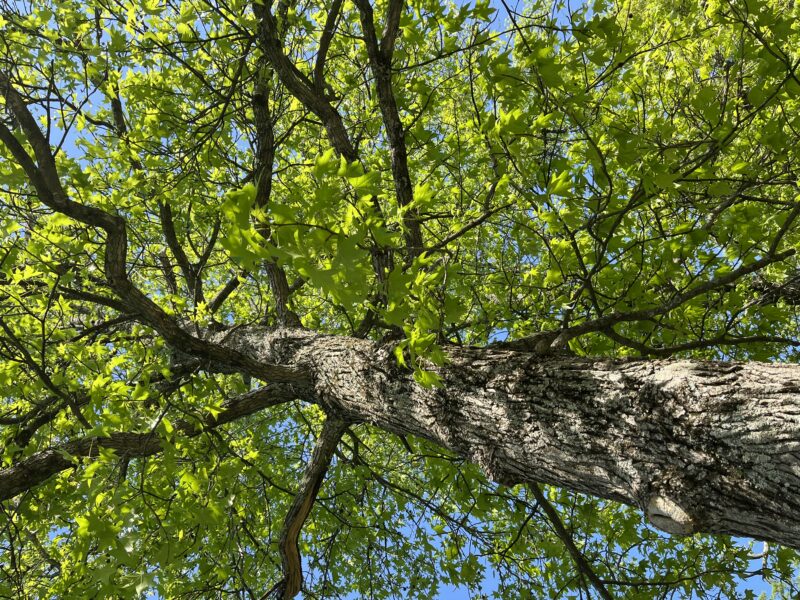 Sugar Gum viewed from the ground.
Sugar Gum viewed from the ground.
This tree was pretty easy to identify because of both the leaf shape but mostly the presence of the fruits. The second photo depicts the leaves in better detail along with the fruits. As seen in image 2, the leaf arrangement is opposite, in simple complexity, with deeply lobed leaves. What I didn’t know about this tree before is that it is part of a genus of only 6 other species of trees. The other trees in the genus only exist in Asia.
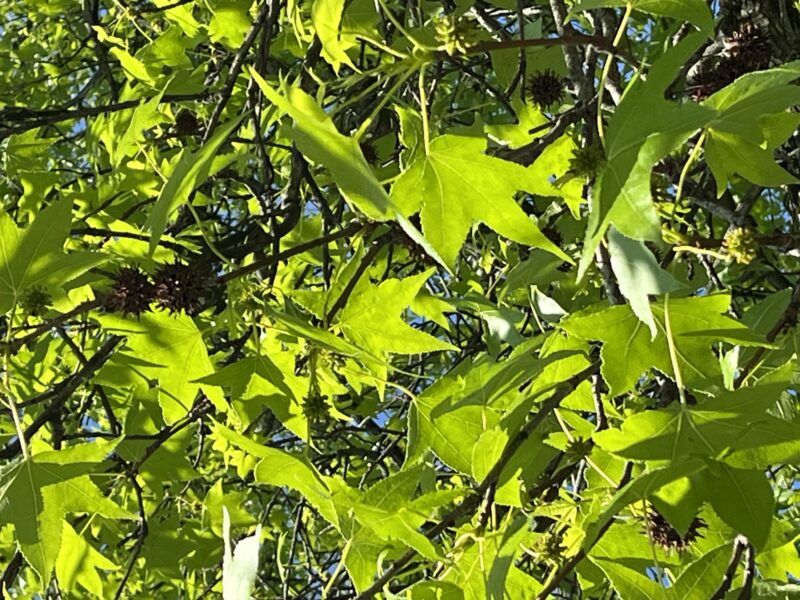 Sugar Maple leaves and fruit are depicted.
Sugar Maple leaves and fruit are depicted.
Sources:
https://www.arborday.org/trees/treeguide/TreeDetail.cfm?ItemID=928
https://www.uky.edu/hort/propagation-sweetgum
Honey Suckle
Honey Suckle is an unfortunate tree to have to photograph but I believe it is an important tree to include due to it being a wildly invasive species in Ohio. From personal experience, I have seen entire regions of forests wiped out by Honey Suckle trees strangling the roots of surrounding trees. This results in devastation to the ground in the area from a lack of structural integrity leaving deserted wetlands in regions that we previously lush. A great example of this is at Antrim Park, I’ll have to take a picture for my Botanical Survey! Upon further research about the history of Honey Suckle, it was once believed that Honey Suckle growing around a home’s entrance was good luck… hard to believe it was good luck now knowing the devastation it actually causes! The scientific name for Honey Suckle is Lonicera tatarica. The habitat that it was found in was near the start of the forest trail but it was common throughout the forest just about everywhere.
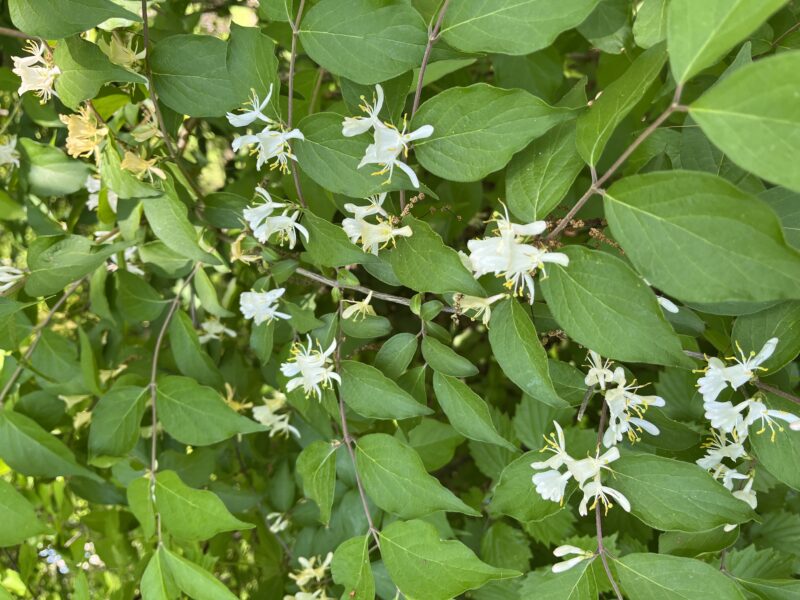 Image of Honey Suckle in bloom, showing the leaf arrangement and flower type.
Image of Honey Suckle in bloom, showing the leaf arrangement and flower type.
Identifying the tree was easy due to it being in bloom but it also has a very easy-to-characterize leaf and bark combination. I personally know how to tell if a tree is Honey Suckle based on the deep wavey bark texture. Besides the bark, the leaves are in an opposite arrangement, have simple complexity, and are entire. The leaves are almost fuzzy to the touch due to how soft they are. The flowers that are currently in bloom are irregular in shape with both male and female parts. the shape and 5 stamens characterize it as being a bloom from a Honey Suckle tree.
Sources:
https://www.woodlandtrust.org.uk/trees-woods-and-wildlife/plants/wild-flowers/honeysuckle/#:~:text=It%20was%20once%20believed%20that,any%20evil%20spirits%20from%20entering.
Blue Ash
Blue Ash, scientific name: Fraxinus quadrangulata, is often used for its lumber. The Blue Ash has more dense wood than other Ashes of the genera Fraxinus. The wood is usually used for making tool handles, furniture, or just firewood. The common name Blue Ash comes from the original use of the bark, pioneers extracted blue dye from the inner bark. The habitat that the Ash was found in was a wooded region of the Battelle Darby.
 Blue Ash photographed on the side of a forest trail
Blue Ash photographed on the side of a forest trail
The leaf arrangement and complexity of Ash trees are indicative of the Genera. Ash trees are pinnately opposite, most other major trees that are opposite in arrangement are not pinnately compound. Besides being compound and opposite, the leaves are entire with slight serration.
Sources:
https://ohiodnr.gov/discover-and-learn/plants-trees/broad-leaf-trees/Blue-Ash-Fraxinus-quadrangulata#:~:text=Like%20green%20ash%20and%20white,to%20green%20in%20most%20years.
Witch Hazel
Witch Hazel, species name: Hamamelis virginiana, is interesting to identify because the leaves have a slightly noticeable purplish color along the veins of the leaves. The petiole is also a large part of characterizing this species from the presence of stipules. The historical use of Witch Hazel has to do with the branch’s shape. A branch of Witch Hazel can be used in divining or better known as water dowsing. This practice is used to find water pockets underground to possibly build a well.
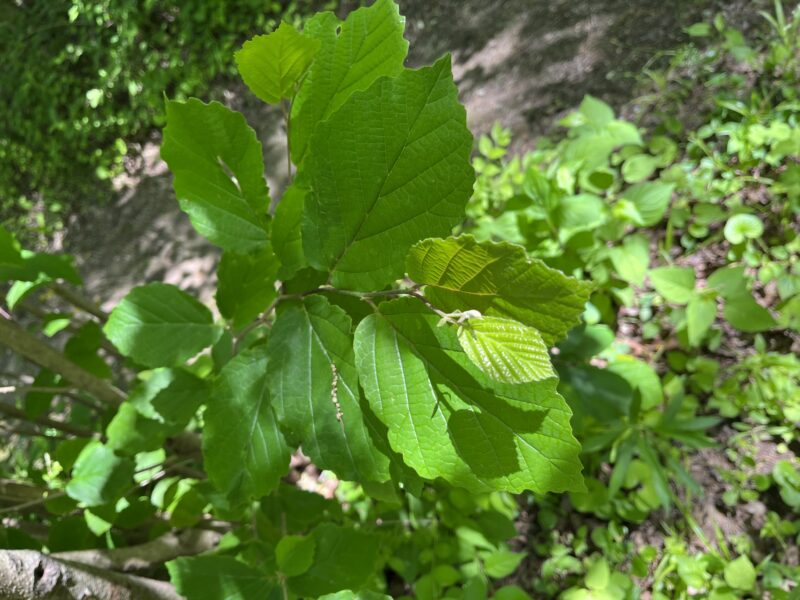 Witch Hazel with purple hues seen in the veins
Witch Hazel with purple hues seen in the veins
Other features used to identify Witch Hazel include alternate arrangement, simple complexity, and a slightly lobed leaf margin. The purple hue from the veins is very telling of a Witch Hazel. They can almost appear shrub-like because they are short in comparison to other trees surrounding them.
Sources:
https://newcanaanlandtrust.org/american-witch-hazel-facts-and-folklore/
Hawthorn
Hawthorn trees unlike the others in this list are much harder to identify down to the species. The Genera of Hawthorn is Crataegus, but the reason the species are harder to determine is due to the number of species there are. In our Peterson field guides, Peterson remarks that there are currently between 100-1000 classified species of Hawthorn throughout the country. He encourages novice readers not to attempt to be more specific than what the reader can see. This particular Hawthorn shows what can be described as frosted leaf shapes, possibly distinguishing it from other species.
Fun fact: Hawthorns historically were used in marriage ceremonies for both ancient Greeks and Romans! It was used as the symbol of home. Many other cultures use Hawthorn in religious imagery.
This Hawthorn was found near a river around a slightly open area of the forest. Hawthorns are easily characterized by the thorns on branches and stem but absent on their leaves. In addition, the arrangement is alternate, with simple complexity, and, in the photographed tree, slightly lobed margins. Note: not all Hawthorns are lobed! Leaves come in many different shapes for this Genera.
Sources:
https://newcanaanlandtrust.org/american-witch-hazel-facts-and-folklore/
Bristly Black Currant
Bristly Black Currant, known scientifically as Ribes lacustre, is related to Gooseberries! They look extremely similar, so much so that I mistook the Bristly Black Currant for a Roundleaf Gooseberry. However, Roundleaf Gooseberries are not native to Ohio so it is less likely to be that species. It is said that both Gooseberries and Currants have medical properties, and historically it has been used to treat fevers in livestock!
The leaf characterization has an opposite arrangement, simple complexity, and lobed leaves. A defining feature of this tree is the thorn stipules and fuzzy texture on both the stem but not the leaves. The flush stems are what sets this species apart from the others.
Sources:
https://southcenters.osu.edu/horticulture/fruits/currants-and-gooseberries#:~:text=Cultivated%20gooseberries%20are%20divided%20into,hirtellum).
American Bladdernut
The American Bladdernut (haha, okay now that that’s out of the way), produces a supposedly edible nut similar to how Walnuts taste. I have not tried them myself nor did I get the opportunity to today due to them not being in season. However, they are not from the same Genera. The scientific name for the American Bladdernut is Staphylea trifolia. Besides their edible purpose, the American Bladdernut can be used to preserve ground moisture without producing a wetland like many other trees might!
 Fruits of the American Bladdernut can be seen drooping slightly below the leaves.
Fruits of the American Bladdernut can be seen drooping slightly below the leaves.
The characterization of this tree has an opposite arrangement with pinnately compound leaves consisting of typically 3 leaflets. The leaves are slightly serrate. In the picture from the sighting, small greenish flowers can be seen with expanding ovaries! The flower and fruit produced set it apart from many other pinnately compound trees.
Sources:
https://www.eraconsultants.com/our-blog/plant-of-the-week-american-bladdernut#:~:text=The%20seeds%20are%20also%20reported,utilized%20in%20landscaping%20as%20well!
White Oak
The White Oak is the final tree identified in this list, the scientific name is Quercus alba. Oaks, in general, have very distinct lobe shapes in comparison to many other trees but in comparison to other Oaks the White Oaks have a very bulbous tip to their leaves. White Oak is extremely important for its timber because of its extremely useful hardwood. Typically it is hard, heavy, and tough wood, making it a good material for lumbar beams, railroad ties, floors, and furniture.
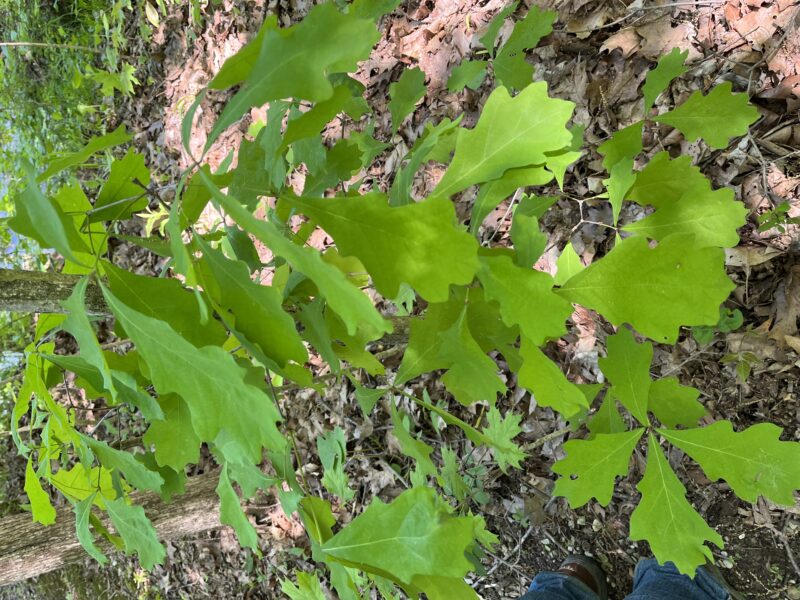 A small White Oak was found near some larger Oaks.
A small White Oak was found near some larger Oaks.
The White Oak found in Batelle Darby was found near a river in the woods, similar to the Hawthorn position. The species can be identified by its leaf configuration as previously mentioned. The characterization is alternate arrangement, simple complexity, and deeply lobed margins.
Sources:
https://ohiodnr.gov/discover-and-learn/plants-trees/broad-leaf-trees/white-oak-Quercus-alba#:~:text=It%20is%20the%20most%20important,furniture%2C%20and%20many%20other%20uses.

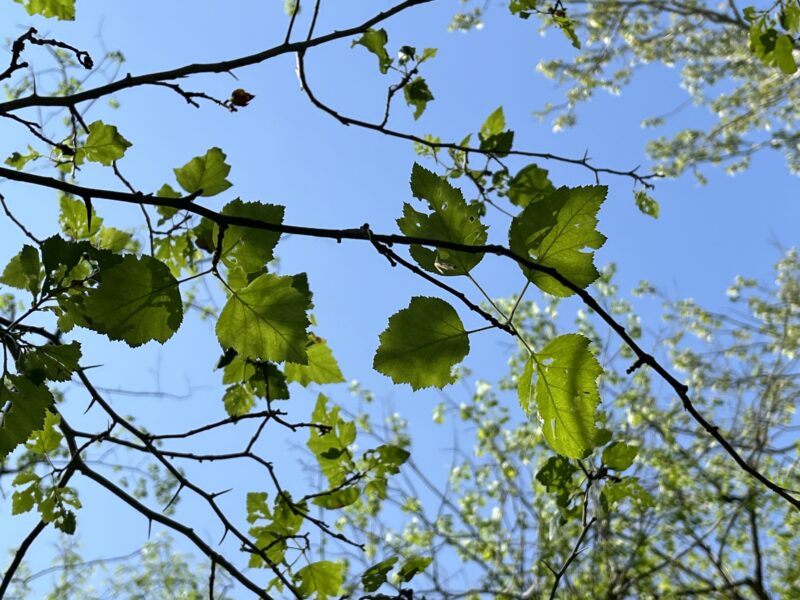 The leaves of this Hawthorn in particular are hard to view due to the insects in the area snacking on it!
The leaves of this Hawthorn in particular are hard to view due to the insects in the area snacking on it! 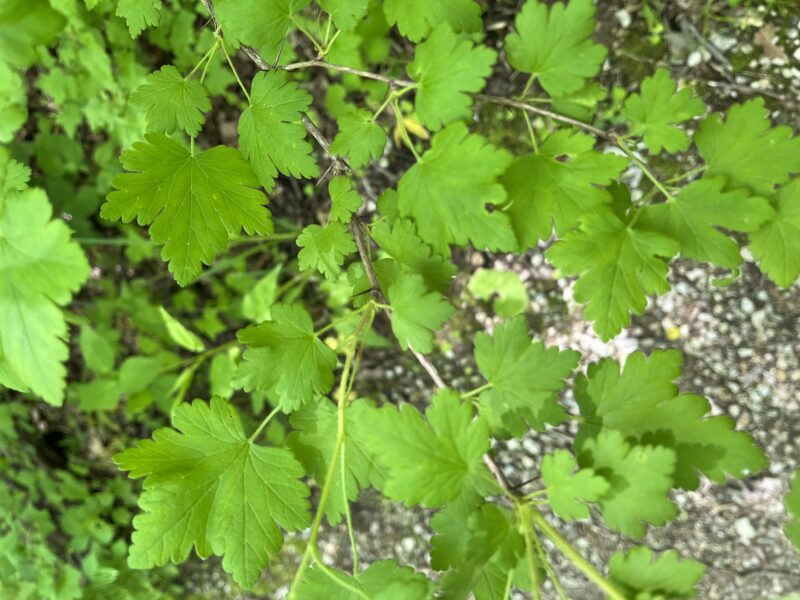 NOT A GOOSEBERRY!!! The differences between Gooseberries and this Black Currant can be seen on the woody stems.
NOT A GOOSEBERRY!!! The differences between Gooseberries and this Black Currant can be seen on the woody stems.